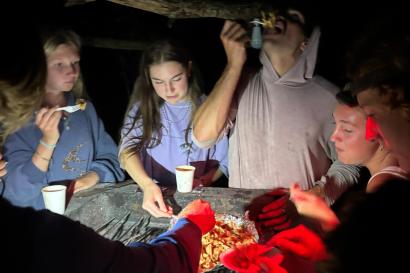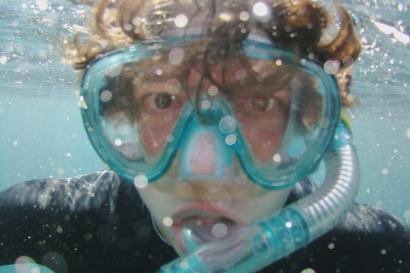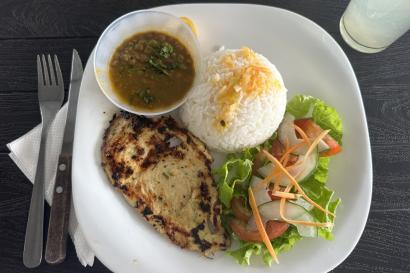This past weekend with IES Abroad, we ventured to the most remote place I have ever traveled - the Tiputini Biological Station, located deep in the Amazon rainforest. The station is part of 1,500 acres of land used for research and education by the Universidad San Francisco de Quito, and sits right at the edge of Yasuní National Park - the most biologically diverse area in the world. Given such great biodiversity, the place was not easy to get to. Although only 200 miles from Quito, it took practically the entire day to get there, involving a plane ride, two bus rides, and two boat rides. Floating down the river late in the afternoon, the sounds of insects, birds, and monkeys soon became ever more encompassing. The humidity was heavy, and I was quickly humbled by the vastness of the forest we were approaching.
Later that night, after arriving at the station and settling into our cabins, we took our first hike around the trails. At first I wasn’t sure the clunky rainboots we all had to wear were necessary, until we soon descended into ditches of thick mud that were almost strong enough to pull them off. On terrain both muddy and firm, we stopped every few meters to admire insects, frogs, and monkeys in the trees. We traced the trails with our headlights until we reached the end of the hike and our guide had us turn them all off. The darkness was immediately arresting. Our voices became headless sounds that defied my sense of space. However, as we looked down, the forest floor lit up with tiny glowing specks. They were bioluminescent mushrooms, our guide told us. Somehow that fact gave me an overwhelming sense of happiness and awe. I looked up and saw a sky full of more stars that I had seen in months. Cradled by glowing lights, a choir of forest sounds, and complete darkness all at once, I felt an incredible sense of magic that this planet holds.
The next morning we woke up early for another hike around the station’s densely forested trails. We stopped frequently to admire fruits, insects, mushrooms, and various other contents of the jungle until we reached a high tower peaking through the canopy. We climbed dozens of flights of stairs and eventually made it to a platform at the treeline. We saw the whole expanse of the forest, the clouds, the strings of leaves falling from the treetops, the river. It was nice to be above the trees after being so enclosed within the trees. We saw a lot of birds, most of whose names I already forgot, but certainly one toucan, which was definitely the coolest. After descending the tower, climbing a tree, and walking over some hilly terrain, we reached an area of the forest that was only sparsely covered with plants. Our guide told us it was because ants managed to make their way into the branches of these plants, and they were so acidic that they prevented others from growing. He opened up the branch of a small tree nearby and it exploded with ants. For reasons I’m still not sure of, our guide had us eat some of these ants, which coated our mouths with a sharp lemony flavor. We made our way back through the forest, splashing through a pool of water, crossing logs, and admiring trees so large its roots looked like walls.
That afternoon we took a boat ride on the river. We jumped in and let our life jackets keep us afloat as the current carried us downstream. It was sunny, which felt unexpected but pleasantly welcome. We shared fears and laughs about the alleged fish that would enter your body if you peed in the water, which made me slightly on edge the whole time but thrilled about the whole experience nonetheless. We sang out in amazement that we were floating in the middle of the Amazon rainforest. There was a moment when I stopped treading water and just let the water take me. It was freeing.
The next morning we went on a beautiful boat ride among a pristine lagoon nearby, and that’s about where all the good times end. Few foreigners make it through a trip to Ecuador without getting sick at least once, and now it was my turn. That afternoon, a terrible sickness struck a handful of our group members and we pretty much spent the rest of the day throwing up. We moved into the one air conditioned room and laid on mattresses on the floor until it was time to head back to Quito the next day.
Luckily, we all felt much better in the morning and were able to make it through the long travel day without vomiting. The wind from the boat ride was refreshing and even helped a bit. However, the day was not without obstacles. Halfway through our first bus ride, a local Kichiwa community stopped us in the middle of the road as they protested against the Ecuadorian state oil company. They were demonstrating because recently Petroecuador assumed responsibility for the oil site in their territory, but did not employ the community members or clean the roads the way the Spanish company that previously had rights to the site did. Although the protest was against the oil company, the community didn’t let us pass, claiming that the university also didn’t do enough to support the community. We were there for hours as our teachers and the station’s staff negotiated with the leaders of the community. Coincidentally, two of them were actually former students of the Universidad de San Francisco, which provides scholarships to members of indigenous communities every year. These leaders vouched for us, but they had to convince the other members of the community. Eventually, they agreed to arrange a meeting between the community and representatives of the university to discuss potential training in community tourism and visits to their farms.
Despite sitting in the heavy heat on an upset stomach for hours, the whole experience was extremely interesting and inspirational. I had just finished a half-semester course in conflict resolution that week, where in many of my assignments, I studied the tension between extractivism and indigenous rights. I also saw direct connections with the class I took last semester with IES Abroad in Argentina, where we studied indigenous issues in Patagonia and took a trip to the region to study the issues first hand. This incident was yet another way in which my study abroad experiences were directly exposing me to some of the most pressing political issues in Latin America, and frankly, the world. It also showed me that as part of a university, we weren’t just passive observers, traveling through. Although we weren’t directly involved in the conflict at hand, we couldn’t be neutral - we had a role. Amidst all the challenges of the trip, I felt grateful for the reminder that these tough experiences are often the most impactful.

Elise Fuente
My name is Elise Fuente and I'm a senior at The George Washington University in Washington, DC. I'm studying International Affairs with a concentration in International Development and I have a keen interest in Latin America. I'm studying in Quito after a semester in Buenos Aires and I hope to keep exploring the region as much as possible! I have passion for sustainability, service, languages, and the outdoors, but sometimes I still dream about being a chef. :)







